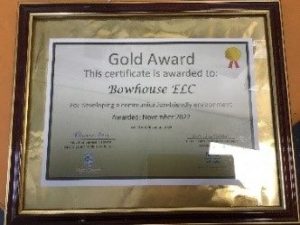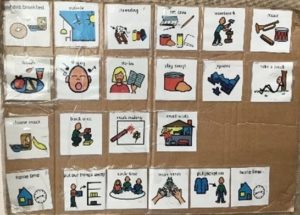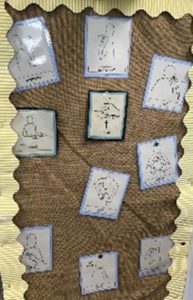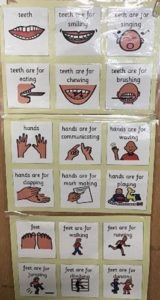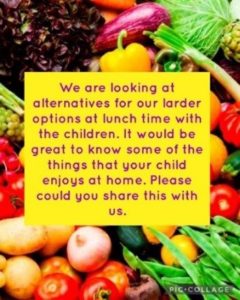
 Everyone has a Voice
Everyone has a Voice
Hello! I’m Kimberley Talbot, Senior EYO at Bowhouse ELC.
At Bowhouse, we have a commitment to support and enable all our children to play, learn and grow on a unique and individual journey of success. Through critical reflection, we identified the use of effective strategies and intervention as a top priority for development. This ensured all children would have a platform to express their wants, needs and views and build capacity for all children’s voice, promoting a rights respecting provision.
Enabling practice to promote the voices with no words
In session 2022/23, practitioners engaged in full team professional learning and development. This ensured there was a consistent approach to intervention and strategies which encompassed a shared vision for high quality care and education. Our increased knowledge and understanding allowed us to offer supportive strategies to our parents and families and build upon trusting and informative relationships.
We have a commitment to building capacity for children’s voice. Article 12 of the UNCRC empowers children to have freedom and respect, to voice their opinion and be heard. This article identifies our responsibility to enable children to have a holistic and appropriate medium to exercise this right. However, our children who are not yet using words and/or have barriers for communication often have difficulty exercising their rights.
We designed a professional learning plan that would promote collaboration and partnership working whilst nurturing a shared vision for success. We collaborated with Speech and Language therapy and Educational Psychology to enable our environment to be communication rich and for our interactions to promote language development and social-emotional abilities.
We embarked on a year-long journey of Adult Child Interaction (ACI) training and SCERTS Model training. This training has enabled practitioners to meet the needs of all children with a universal approach and provided a platform for targeted and individualised supports for children with communication difficulties. We now have a deeper understanding of how to support social communication and emotional regulation by ensuring experiences and spaces are predictable and desirable. Thus, providing high quality care and education that promotes self-identity and inclusion.
We have provided children with objects of reference to support transitions within the session and enable them to make choice and express opinion. These objects have become a vehicle for self-expression and provide a visual learning support for children not yet using words.
 The objects are resources that are meaningful to each child and mirror our What Matters to Me? approach. For example, one child identifies a box of ‘Moshi Monsters’ as a self-regulation tool.
The objects are resources that are meaningful to each child and mirror our What Matters to Me? approach. For example, one child identifies a box of ‘Moshi Monsters’ as a self-regulation tool.
Another child uses a bag of resources as their way of communicating they would like 1-1 time.
of communicating they would like 1-1 time.
This professional learning identified that children benefit most when engaged in stimulating interactions that are led by the child and facilitated by practitioners imitating their communication and adding in language as the interaction deepens.
Trusting and enabling relationships have grown, with practitioners becoming more in-tune to the communication and emotional needs of each child. This has led to children with ASN being able to successfully communicate their wants, needs and views by using gestures, expressions and movements that are understood by the adults and learners within the setting.
Child-centred policies influence our practice and ensure all practitioners offer children experiences and opportunities that are guided by their individual dispositions and pathways for learning. This gives individual platforms for self-expression and a variety of modes for information gathering outlined in article 13.
In October 2022, Bowhouse ELC were awarded GOLD for our visual environment. Enabling leadership, across our improvement priorities, practitioners took the responsibility of upskilling themselves with Boardmaker and were able to provide a variety of visual supports for our environment. These visuals also took the form of ‘real life’ images to support the developmental needs of our children as both social partners and language partners. This ensured our children who were not yet using words and/or had difficulty understanding and following routine, would have ample visual aids to support their social communication and transitions. We are now working towards a diamond award for our spoken environment.
Promoting children’s rights through continuous provision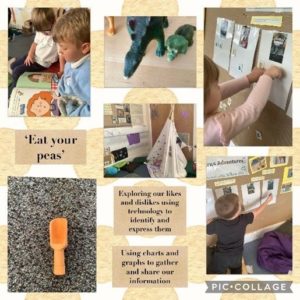
We exercise and explore children’s rights through our continuous provision. Through our Book of the Moment and role play provision, children are encouraged to express their creativity, imagination, and knowledge independently. This session, we used “Daisy Eat Your Peas” as a catalyst for our children to express their likes and dislikes. We used a variety of technology to take photographs of all the areas and resources within the ELC, enabling the children to express their ideas and share their views. We then printed them off and displayed them on the wall. We used the colour monster characters ‘happy’ and ‘sad’ as a visual aid to gather the views of each child.
A golden thread was evident throughout the planning cycle showing that the children’s voice was clear and visible. Children had a platform to build capacity and have their wants and views heard. As a setting, we continue to consult with children on what they’d like to learn and engage with amongst their spaces. A focus on article 12 of UNCRC was adopted as a catalyst for our provision moving forward. On the children’s planning wall, there is a visual chart that enables children to express their views and inform their learning.
An example of this was within Marvellous Mealtimes, our children created and impl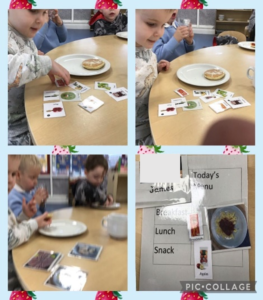 emented their weekly menu and shopping lists. Visual aids continued to support all communication abilities and our families were consulted to build upon an inclusive approach to provision.
emented their weekly menu and shopping lists. Visual aids continued to support all communication abilities and our families were consulted to build upon an inclusive approach to provision.
Our vision is for all children to exercise their rights and build capacity for all voices whether they are spoken or physical.
